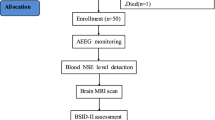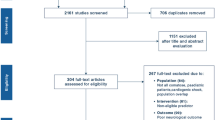Abstract
Objective.
The aim of this study was to investigate whether serial serum neuron-specific enolase (NSE) can be used to predict neurological prognosis in patients remaining comatose after cardiopulmonary resuscitation (CPR).
Design.
Observational cohort study. Clinicians were blinded to NSE results.
Setting.
Eighteen-bed general ICU.
Patients.
Comatose patients admitted to the ICU after CPR.
Interventions.
Serum NSE was measured at admission and daily for 5 days.
Measurements and results.
Patients received full intensive treatment until recovery or until absence of cortical response to somatosensory evoked potentials more than 48 h after CPR proved irreversible coma. Of the 110 patients included (mean GCS at ICU admission 3, range 3––9), 34 regained consciousness, five of whom died in hospital. Seventy-six patients did not regain consciousness, 72 of whom died in hospital. Serum NSE at 24 h and at 48 h after CPR was significantly higher in patients who did not regain consciousness than in patients who regained consciousness (at 24 h: median NSE 29.9 µg/l, range 1.8–250 vs 9.9 µg/l, range 4.5–21.5, P <0.001; at 48 h: median 37.8 µg/l, range 4.4–411 vs 9.5 µg/l, range 6.2–22.4, P = 0.001). No patient with a serum NSE level >25.0 µg/l at any time regained consciousness. Addition of NSE to GCS and somatosensory evoked potentials increased predictability of poor neurological outcome from 64% to 76%.
Conclusions.
High serum NSE levels in comatose patients at 24 h and 48 h after CPR predict a poor neurological outcome. Addition of NSE to GCS and somatosensory evoked potentials increases predictability of neurological outcome.

Similar content being viewed by others

References
Zandbergen EG, de Haan RJ, Stoutenbeek CP, Koelman JH, Hijdra A (1998) Systematic review of early prediction of poor outcome in anoxic-ischaemic coma. Lancet 352:1808–1812
van de Wetering J, van der Hoeven JG, van Dijk JG, Meinders AE (1997) When to stop treatment in comatose patients after successful cardiopulmonary resuscitation? A practical approach. Neth J Med 51:91–95
Gendo A, Kramer L, Hafner M, Funk GC, Zauner C, Sterz F, Holzer M, Bauer E, Madl C (2001) Time-dependency of sensory evoked potentials in comatose cardiac arrest survivors. Intensive Care Med 27:1305–1311
Nakabayashi M, Kurokawa A, Yamamoto Y (2001) Immediate prediction of recovery of consciousness after cardiac arrest. Intensive Care Med 27:1210–1214
Schaarschmidt H, Prange HW, Reiber H (1994) Neuron-specific enolase concentrations in blood as a prognostic parameter in cerebrovascular diseases. Stroke 25:558–565
Zandbergen EG, de Haan RJ, Hijdra A (2001) Systematic review of prediction of poor outcome in anoxic-ischaemic coma with biochemical markers of brain damage. Intensive Care Med 27:1661–1667
Dauberschmidt R, Zinsmeyer J, Mrochen H, Meyer M (1991) Changes of neuron-specific enolase concentration in plasma after cardiac arrest and resuscitation. Mol Chem Neuropathol 14:237–245
Fogel W, Krieger D, Veith M, Adams HP, Hund E, Storch-Hagenlocher B, Buggle F, Mathias D, Hacke W (1997) Serum neuron-specific enolase as early predictor of outcome after cardiac arrest. Crit Care Med 25:1133–1138
Stelzl T, von Bose MJ, Hogl B, Fuchs HH, Flugel KA (1995) A comparison of the prognostic value of neuron-specific enolase serum levels and somatosensory evoked potentials in 13 reanimated patients. Eur J Emerg Med 2:24–27
Martens P, Raabe A, Johnsson P (1998) Serum S-100 and neuron-specific enolase for prediction of regaining consciousness after global cerebral ischemia. Stroke 29:2363–2366
Martens P (1996) Serum neuron-specific enolase as a prognostic marker for irreversible brain damage in comatose cardiac arrest survivors. Acad Emerg Med 3:126–131
Schoerkhuber W, Kittler H, Sterz F, Behringer W, Holzer M, Frossard M, Spitzauer S, Laggner AN (1999) Time course of serum neuron-specific enolase. A predictor of neurological outcome in patients resuscitated from cardiac arrest. Stroke 30:1598–1603
Karkela J, Bock E, Kaukinen S (1993) CSF and serum brain-specific creatine kinase isoenzyme (CK-BB), neuron-specific enolase (NSE), and neural cell adhesion molecule (NCAM) as prognostic markers for hypoxic brain injury after cardiac arrest in man. J Neurol Sci 116:100–109
Author information
Authors and Affiliations
Corresponding author
Rights and permissions
About this article
Cite this article
Meynaar, I.A., Straaten, H.M.Ov., van der Wetering, J. et al. Serum neuron-specific enolase predicts outcome in post-anoxic coma: a prospective cohort study. Intensive Care Med 29, 189–195 (2003). https://doi.org/10.1007/s00134-002-1573-2
Received:
Accepted:
Published:
Issue Date:
DOI: https://doi.org/10.1007/s00134-002-1573-2



